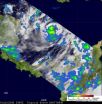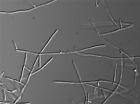The study, published online by the journal Nature, demonstrates that proteins issuing stop and start commands to a cancer gene – known as epigenetic "reader" proteins – can be targeted for future cancer therapies. The research is particularly relevant to a rare but devastating cancer of children and young adults known as NUT midline carcinoma (NMC) – a disease so obstinate that no potential therapy for it has ever reached the stage of being tested in a clinical trial.
"In recent years, it has become clear that being able to control gene activity in cancer – manipulating which genes are 'on' or 'off' – can be a high-impact approach to the disease," says the study's senior author, James Bradner, MD, of Dana-Farber. "If you can switch off a cancer cell's growth genes, the cell will die. Alternatively, switching on a tissue gene can cause a cancer cell to become a more normal tissue cell."
In this study, Bradner's lab synthesized a molecule that has both effects: by blocking a specific abnormal protein in NUT midline carcinoma cells, it stops them from dividing so prolifically and makes them 'forget' they're cancer cells and start appearing more like normal cells.
The assembled molecule affects the cell's multi-layered apparatus for controlling gene activity, a set of structures collectively known as the epigenome. Vast portions of each gene play a regulatory role, dictating whether the gene is active, busily sending orders for new proteins, or inactive, and temporarily at rest. The gene's DNA is packaged in a substance called chromatin, which is the slate on which instructions to begin or cease activity are inscribed.
The instructions themselves take the form of "bookmarks," substances placed on the chromatin by so-called epigenetic "writer" proteins. Another group of epigenetic proteins, known as "erasers," are able to remove the bookmarks. Both types of proteins have successfully been disabled by scientists, using molecules made in the lab or taken from nature. Their success has sparked intense interest in the development of anti-cancer therapies that work by blocking such proteins.
A third variety of epigenetic proteins – potentially the most appealing as therapeutic targets, because they switch genes on or off by "reading" the bookmarks – has received scant scientific attention. Bradner and his colleagues turned to this little-explored corner of biology by focusing on NMC cells.
The disease is caused by a chromosomal "translocation," in which two genes from different chromosomes become connected and give rise to an abnormal, fused protein known as BRD4-NUT. A review of the scientific literature suggested that some members of the benzodiazepine family of drugs, which includes Valium, Xanax and Ativan, are active against "bromodomain" proteins such as BRD4. With that as a clue, Bradner and his Dana-Farber colleague Jun Qi, PhD, created an array of molecules to see if any inhibited a "reader" protein of the BRD4-NUT gene. One did, quite convincingly – a hybrid molecule, which researchers named JQ1, for Qi.
The investigators worked with researchers in the U.S. and overseas to learn more about the properties of JQ1 and how it works in cells. Stefan Knapp, PhD, of Oxford University in England, provided crystal-clear images of the molecule bound to a protein; Olaf Wiest, PhD, of the University of Notre Dame, showed that the molecule is less flexible in the presence of a protein, explaining why it so effectively blocks the protein; and Andrew Kung, MD, PhD, of Dana-Farber, engineered animal models in which the molecule could be tested against NMC tumors.
The animal studies were especially encouraging. Investigators transplanted NMC cells from patients into laboratory mice, which were then given the JQ1 molecule.
"The activity of the molecule was remarkable," says Bradner, who is also an associate member of the Chemical Biology Program at the Broad Institute of Harvard and MIT. "All the mice that received JQ1 lived; all that did not, died."
For now, JQ1's main utility is as a probe for better understanding the biology underlying NUT midline carcinoma. Bradner, Qi and their colleagues are tweaking the molecule to maximize its effectiveness as a BRD4-NUT stopper. Eventually, it, or a similar molecule, could be the basis for the first effective therapy against NMC.
"The disease tends to arise in the chest, head, or neck, along the vertical centerline of the body, with aggressive tumor growth and metastasis," Bradner explains. "Patients may have a brief response to chemotherapy, but they eventually succumb to the spread of the disease."
Unlike most cancers, NMC's tissue of origin isn't known. It is a disease defined entirely by its genetic signature – the presence of the translocated gene BRD4-NUT. Prior to its genetic identification by Christopher French, MD, of Brigham and Women's Hospital and a study co-author, NMC wasn't recognized as a distinct disease.
"This research further illustrates the promise of personalized medicine," Bradner remarks, "which is the ability to deliver selected molecules to cancer-causing proteins to stop the cancer process while producing a minimum of residual side effects. The development of JQ1 or similar molecule into a drug may produce the first therapy specifically designed for patients with NMC."
###
In addition to Qi, the study's other lead authors are Panagis Filippakopoulos and Sarah Picaud, of Oxford University, England. The paper's co-authors include William Smith, Elizabeth Morse, Michael McKeown, Yuchuan Wang, PhD, Amanda Christie, and Nathan West, of Dana-Farber; Oleg Fedorov, Tracey Keates, Ildiko Felletar, Martin Philpott, Shonagh Munro, Tom Heightman, and Nicholas La Thangue, of Oxford University; and Tyler Hickman, Michael Cameron, and Brian Schwartz, PhD, of Brigham and Women's Hospital.
The study was supported in part by the Chemistry-Biochemistry-Biology Interface Program at the University of Notre Dame, Dana-Farber/Harvard Cancer Center, the National Institute of General Medical Sciences, the National Institutes of Health, the Burroughs Welcome Fund, and the Leukemia & Lymphoma Society.
Dana-Farber Cancer Institute (www.dana-farber.org) is a principal teaching affiliate of the Harvard Medical School and is among the leading cancer research and care centers in the United States. It is a founding member of the Dana-Farber/Harvard Cancer Center (DF/HCC), designated a comprehensive cancer center by the National Cancer Institute. It provides adult cancer care with Brigham and Women's Hospital as Dana-Farber/Brigham and Women's Cancer Center and it provides pediatric care with Children's Hospital Boston as Dana-Farber/Children's Hospital Cancer Center. Dana-Farber is the top ranked cancer center in New England, according to U.S. News & World Report, and one of the largest recipients among independent hospitals of National Cancer Institute and National Institutes of Health grant funding.
END



